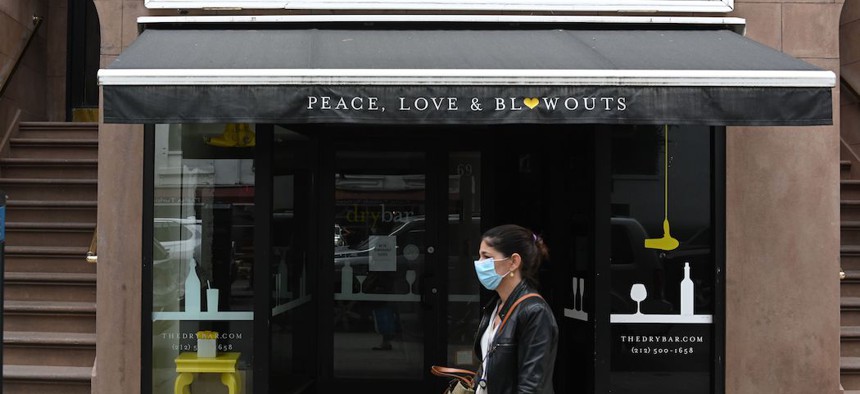New York State
NY should rethink its reopening plans
With new data available regarding COVID-19’s transmissibility, the state would be wise to rethink some of the industries it’s allowing to reopen.

If the coronavirus is airborne, reopening certain businesses such as nail, hair and tanning salons and tattoo shops – all of which are included in Phase Three – may not be as safe as previously thought. Erik Pendzich/Shutterstock
The majority of New York’s regions are on the cusp of entering into Phase Four, the final phase in the state’s reopening plan, which allows malls, indoor and outdoor arts and entertainment, and higher education to reopen. However, given the bulk of new data that’s become available on COVID-19’s transmissibility since the state’s reopening plan was laid out on May 4, it may want to rethink what industries it has allowed (or plans to allow) to reopen.
Many states that began reopening ahead of New York, including Texas, Florida and Arizona, are seeing huge spikes in new coronavirus cases, hospitalizations and deaths, with most of the new infections stemming from eating indoors and going to bars.
Last week, this led New York City to remove indoor dining from its entry into Phase Three. However, indoor dining was not banned in other regions that had already entered into Phase Three, despite the apparent risk. If New York wants to continue to keep its number of new coronavirus cases and deaths as low as they have been, it may have to reconsider the risks associated with other activities and industries being allowed to reopen throughout the state – not only in New York City.
“I think that we do need to be open to the fact that as we learn more about the virus, and how it spreads, and the idea that indoor ventilation systems may contribute to viral spread, we should be open to considering whether or not certain indoor spaces in particular makes sense to be open or not,” Rachael Piltch-Loeb, a research scientist at New York University’s School of Global Public Health, told City & State.
“I think opening also relates to what the underlying infection rates are in the area and how widespread community transmission is,” Piltch-Loeb continued. “I think in most of the areas of New York where reopening has proceeded, there's relatively low community transmission … so if we don't think there is widespread community transmission, perhaps those indoor spaces are OK to be in. But we need to be willing to think through whether or not that makes sense.”
On Saturday, 239 medical experts sent a letter to the World Health Organization stating that they believe that COVID-19 is airborne, which means the virus can stay suspended in the air for hours and can be carried through the air. WHO is now investigating this claim and reviewing data to assess whether or not this is accurate.
If the coronavirus is airborne, reopening certain businesses such as nail, hair and tanning salons and tattoo shops – all of which are included in Phase Three – may not be as safe as previously thought. “If we started revisiting airflow, we would have to be prepared to change a lot of what we do,” Mary-Louise McLaws, an epidemiologist at the University of New South Wales in Sydney, told The New York Times.
Businesses would need to make certain adjustments, such as purchasing powerful new ventilation systems and filters to clean the air and decrease its recirculation, and ultraviolet lights to kill virus particles suspended in the air. Masks will also need to be worn at all times to reduce the risk of transmitting or contracting the virus. “In my mind, it's not necessarily that the overall response strategy (in New York) should change so much, it's just that we need to be much more conscientious as we think, in particular, about reopening indoors and encouraging facial coverings,” Piltch-Loeb said.
Remaining outdoors is still preferable to venturing indoors, however. “I think that we want to create a hierarchy of spaces where the risk (of contracting COVID-19) is the lowest (and the highest),” Piltch-Loeb said. “In general, big outdoor spaces should be most encouraged and small indoor spaces should be the least. But we have to be realistic about the fact that people are going to interact. I think it's helpful to basically share information about what some of the most reasonable spaces to be in would be.”
Since there’s still so much to uncover about COVID-19, it’s important that when new discoveries are made they are reflected in New York’s reopening strategy, even if that means taking what some may consider a few steps backwards. This information also needs to be transmitted to the state’s residents so they do not have to deal with the complex task of assessing the risk of certain activities.
“Individuals are being asked to decide for themselves what chances they should take, but a century of research on human cognition shows that people are bad at assessing risk in complex situations,” Tess Wilkinson-Ryan, a professor of law and psychology at the University of Pennsylvania, wrote in The Atlantic. “During a disease outbreak, vague guidance and ambivalent behavioral norms will lead to thoroughly flawed thinking. If a business is open but you would be foolish to visit it, that is a failure of leadership.”
NEXT STORY: Cuomo overrules de Blasio on reopening schools

